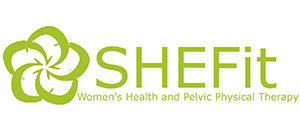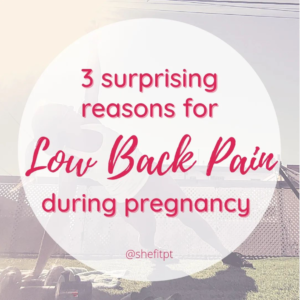3 Surprising Reasons for Low Back Pain During Pregnancy… & Tips to Fix It!
By Dr. Sheri DeSchaaf, DPT
As Physical Therapists, low back pain is our “bread and butter”. Low Back Pain (during pregnancy or otherwise,) is one of the MOST common complaints in the U.S.
Most primary care or orthopedic physicians will send the sufferer to physical therapy ASAP, but pregnant women are not so fortunate – for some reason OBGYNs prefer to let women “wait until baby comes”.
There are MANY reasons pregnant women can have back pain. The #1 front line treatment besides pain medication is physical therapy, and trust me….you should definitely see a prenatal specialist for your prenatal back pain!
This post is mostly about 3 SURPRISING causes, but first I have to mention one well-known reason for prenatal back pain: postural change.
There are two main types of sub-optimal “pregnancy posture” we see, and BOTH can contribute to low back pain.
Do you?:
1. Go sway-back with your back over-extended and pelvis tilted forward?
2. Go “bum-tucked”, slumping your pelvis forward and thorax back?
Both positions appear to create a bigger lumbar curvature, but the corrections are very different!
Both positions can create excess compression in your low back, muscle tightness, and pain. It can be very difficult via an untrained and non-objective eye to tell which category you are in, but this is what physical therapists are trained to do. We are here to assess how your body is adapting to pregnancy and teach you how to adapt, stay strong, minimize discomfort, and ROCK your pregnancy! (P.S. we see the SAME postures persist postpartum, so if you’re 1 year or 10 years post-pregnancy, we can still help!)
Posture isn’t the only culprit. So without further ado, here is a brief summary of 3 more SURPRISING reasons for back pain, and a list of tips to start addressing YOUR back pain!
1. Abdominal muscle TENSION
2. Rib cage RESTRICTION
3. Hip TIGHTNESS
(**Remember, tips and tricks online are NOT a substitute for a thorough examination and assessment by your physical therapist, with personalized exercise and activity prescription. If your pain is persistent, book an evaluation ASAP!)
1. People tend to think their abdominal muscles are “weak”, and certainly core weakness can contribute to back pain. But sometimes your abs might also be TENSE!
Your abdomen STRETCHES during pregnancy, which makes your abdominal muscles less efficient, or functionally “weaker”. When muscles are struggling to do what you need them to, they get TENSE, and that tension creates strain on your thoracolumbar and lumbopelvic myofascial system (muscles+ tendons+ fascia), causing PAIN. (read on for tips on how to relieve this!)
2. Throughout pregnancy, your growing baby takes up more and more space in your abdomen, pushing your ribs up and out of the way. The diaphragm has less space to descend, which means less rib motion, resulting in ribcage restriction. When the ribs are stuck, the back muscles that attach to them also get stuck, which can result in tension and PAIN. (Your neck muscles may also work harder to help you breathe, which can contribute to neck pain and headaches.)
3. Most people have heard of the hormone relaxin. Everyone assumes relaxin in the pregnant pelvis makes the hips loose. But often increased pelvic joint laxity causes the muscles of the hips to tighten as they strive to stabilize the loosening, widening pelvis and increasing anterior load in your belly. Tight hip muscles may lead to back pain! When your hips don’t move well in the pelvis, that may force more movement in the pelvic joints and lumbar/sacral joints. With relaxin in the mix, that can contribute to pain and muscle guarding in the back. Read on for stretches to address hip stiffness.
Now, want some tips to ease your back pain?
• RELEASING abdominal tension and REDUCING ribcage restriction:
1. Deep breathing! Promoting optimal movement of the ribcage, abdomen and
diaphragm will help reduce any abdominal tension you are acquiring throughout the day.
2. Gentle stretching. Check out this yoga-based movement from Dr. Kelsey to get your ribs and abs moving, plus a BONUS tip for birth prep.
3. Rotation stretching. Gentle stretches into thoracic rotation like a seated twist combined with deep breathing can really help free up your ribcage! A supine spinal twist is great in early pregnancy, but if that gets uncomfortable, try seated or hands and knees as a modification.
• Hip Stiffness
1. Relaxin in your system does not mean you shouldn’t stretch! While you don’t want to aggressively stretch to the end-range of your joints, GENTLE stretching of tense muscles can be very helpful.
Check out this YouTube video for some of our PTs’ favorite stretches for back pain!
2. It MATTERS that you stretch what’s tight, not just what’s sore – a qualified
prenatal pelvic PT will help you identify what’s actually tight and what might be sore from nerve irritation, laxity, or instability (stretching won’t help and could aggravate things.)
3. Common areas of tension that can contribute to back pain include the piriformis, glutes, hamstrings, calves, hip flexors, quads, lumbar muscles, lateral abdominals, pecs, and traps. Watch the video for a few ideas on pregnancy-safe stretches, then book a visit for an individually tailored program!
4. If you’re trying to stretch the hip/thigh, that’s where you want to isolate the motion. With HIP stretches, it’s best to keep the lumbar spine and pelvis NEUTRAL, as indicated in the video.
I interviewed each of my fellow SHEFit PTs for their top back pain exercises. Check out the YouTube compilation here , and read below for details.
Dr. Jessica described 4 dynamic stretches for the hip flexors, groin and hamstrings.
-Tight Hip flexors can pull on your spine, directly creating back pain. Your psoas also runs along the spine and acts as a spinal mover, so a tight psoas can actually feel like back pain!
-Tight hamstrings attach to your sit bones and may pull the pelvis into “posterior rotation”, placing strain on your low back. (See my prior Instagram post on posture!)
-Tight adductors (also known as your inner thighs or groin) pull your leg to the center, reducing the mobility of your hips with walking and other movements, which may place more strain on the muscles and joints of the low back.
**Bonus Tip: tight adductors are also associated with pelvic floor and bladder
symptoms, and can contribute to pubic symphysis dysfunction!
Dr. Kelsey brought up one of the biggest complaints during AND after pregnancy – pain getting on and off the floor, especially holding a baby! (For preggos, you are technically “holding” a baby, so this applies to you too!) (watch the video for a demonstration)
Which method you choose will be based on YOUR body – some factors include:
– history of knee pain may make half kneeling difficult
– poor hip mobility may make deep squatting difficult
– poor balance may make half kneeling OR deep squatting risky depending on your specific balance challenges
– poor hip strength may make rising via a lunge more challenging
– history of pelvic organ prolapse may make the deep squat uncomfortable, especially during pregnancy
– the list goes on…
As PTs who specialize in pregnancy and pelvic floor, we know how to assess your history and movement patterns to find the best option for you and assign specific exercises to improve your ability to use one or both of these strategies and get OFF the FLOOR without pain, safely, holding your babe! (For individualized help, book a visit!)
When your back feels TIGHT, it feels great to stretch! One of Dr. Kelsey’s favorites is inspired by the yoga pose “half moon”. This movement creates length in not only the lumbar (low back) muscles like the quadratus lumborum and erector spinae, but also in the lateral abdominals, psoas, lateral hip muscles (glute med and TFL), and IT band! This stretch is very easy to do throughout the day for some relief! (Did you know Dr. Kelsey teaches small group prenatal yoga classes every Saturday in our Mission Valley office? Book online here!
Dr. Ellen’s first mention was abdominal myofascial release – this is a hands on technique that she is more than happy to show you in the clinic! She also selected two lumbar flexion stretches to target the lumbar extensors. The lumbar extensors can get tight when you have a more”lordotic” posture (“swayback”), or when you overuse your back muscles to compensate for a weak deep core system. Watch Dr. Ellen’s demo in the the last portion of our stretch video. One stretch in back lying using a foam roller to deepen the stretch on the lumbar extensors, and the other a modification in standing/squatting in case back lying is not comfortable or advisable for your body.
Tired of trying “tips and tricks” and still being in pain? We are your experts when it comes to prenatal back pain! Call us for an appointment and we’ll help you get to the root of your pain and create an individualized recovery plan just for you!
Schedule now at https://shefitpt.janeapp.com. We can’t wait to help you have a strong, comfortable pregnancy and postpartum!


